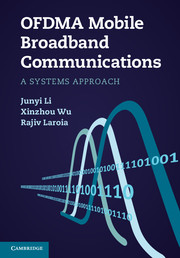Book contents
- Frontmatter
- Dedication
- Contents
- Foreword
- Preface
- List of Notation
- List of Abbreviations
- 1 Introduction
- 2 Elements of OFDMA
- 3 System design principles
- 4 Mitigation and exploitation of multipath fading
- 5 Intra-cell user multiplexing
- 6 Inter-cell interference management
- 7 Use of multiple antennas
- 8 Scheduling
- 9 Handoff in IP-based network architecture
- 10 Beyond conventional cellular frameworks
- A Overview of system operations
- B OFDM point-to-point communications
- C Brief review of channel capacity
- References
- Index
A - Overview of system operations
Published online by Cambridge University Press: 05 July 2013
- Frontmatter
- Dedication
- Contents
- Foreword
- Preface
- List of Notation
- List of Abbreviations
- 1 Introduction
- 2 Elements of OFDMA
- 3 System design principles
- 4 Mitigation and exploitation of multipath fading
- 5 Intra-cell user multiplexing
- 6 Inter-cell interference management
- 7 Use of multiple antennas
- 8 Scheduling
- 9 Handoff in IP-based network architecture
- 10 Beyond conventional cellular frameworks
- A Overview of system operations
- B OFDM point-to-point communications
- C Brief review of channel capacity
- References
- Index
Summary
Strictly speaking, OFDMA is merely a multiple access principle of sharing spectrum. To build a full-fledged mobile broadband communication system, one needs to design a whole set of system operations. We highlight a few important elements of the required system operations in Figure A.1 and provide a high level overview in this section.
Cell search, synchronization, and identification
After power-up, the user first detects the existence of a base station in the area by searching for some signal signature in the downlink. Below are some examples of commonly used signal signature:
• Correlation between cyclic prefix and the last portion of the OFDM symbol (see Section B.2 for cyclic prefix correlation).
• Synchronization channel, which consists of pre-defined signal waveforms with special properties, such as autocorrelation function close to a delta function (see Section 9.5 for an example of synchronization channel).
• Common pilot channel, which consists of a subset of high power tone-symbols distributed according to pre-defined patterns (see Section B.3 for an example of pilot channel).
• Beacon channel, which consists of a special OFDM symbol in which most of signal power is concentrated on one tone-symbol (see Section 9.5 for the use of beacon channel).
Once the user has discovered a base station, it synchronizes its carrier frequency, clock, and symbol time with the received downlink signal and then retrieves from the broadcast channel certain system information, such as system time, base station identifier, operator identifier.
- Type
- Chapter
- Information
- OFDMA Mobile Broadband CommunicationsA Systems Approach, pp. 461 - 466Publisher: Cambridge University PressPrint publication year: 2013



